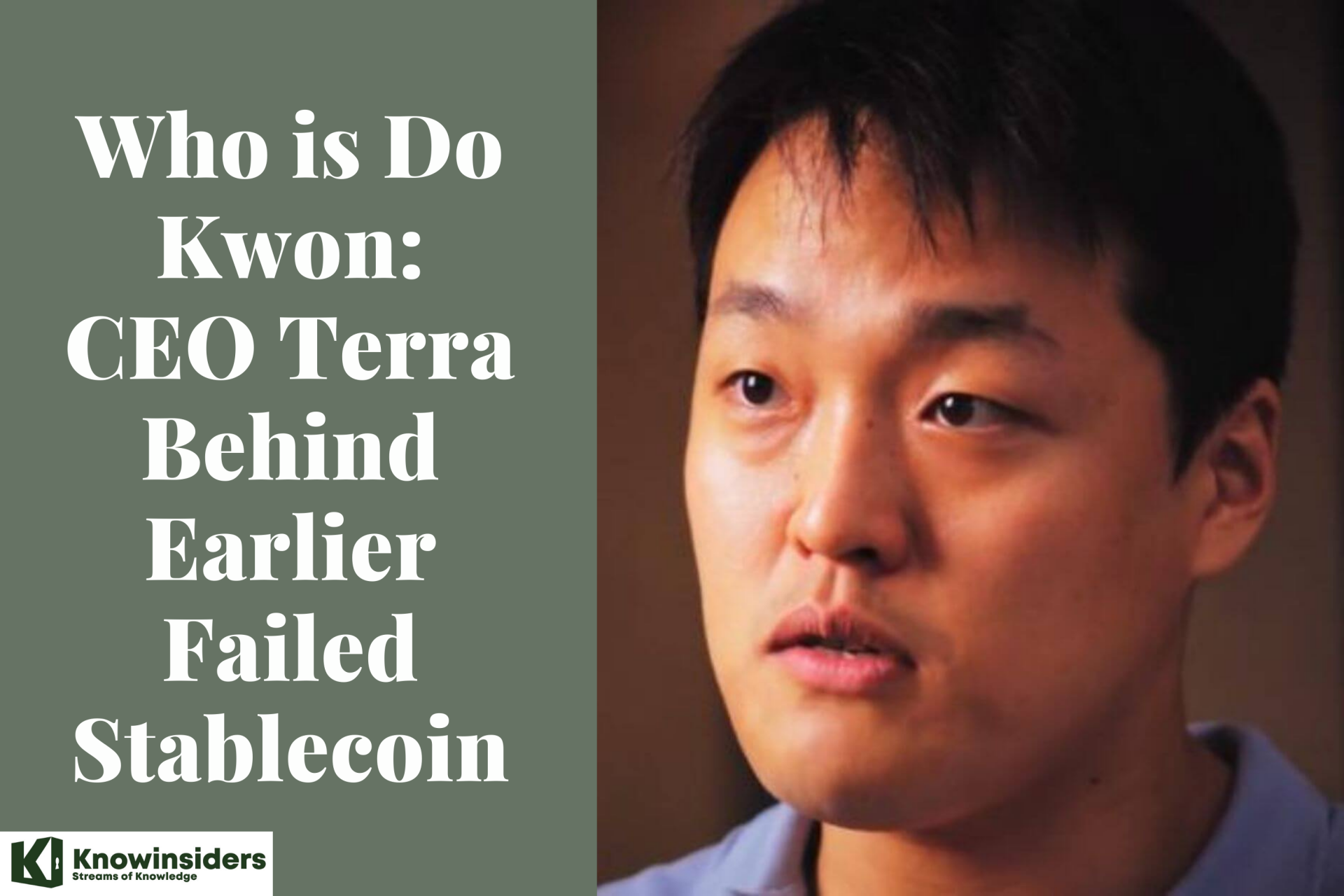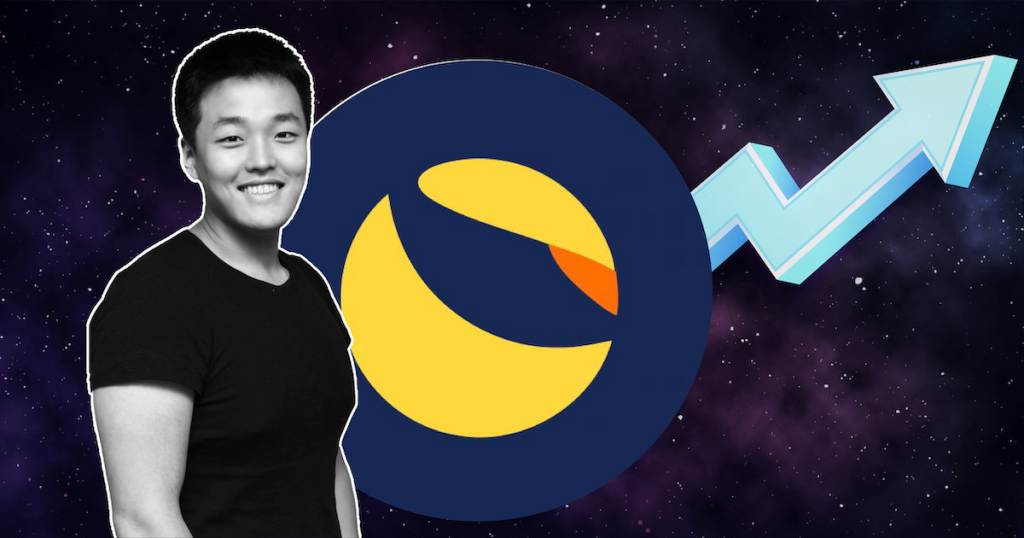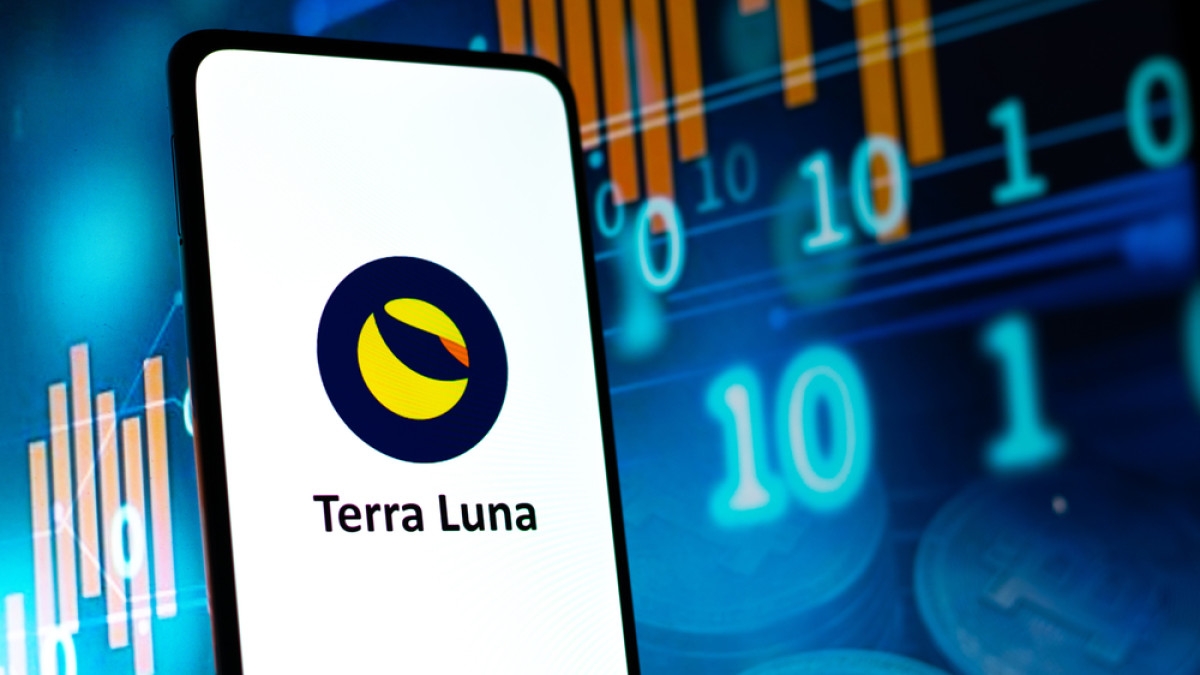Who is Do Kwon-Terra Luna Founder: Biography, Family, Career and Net Worth
 |
| Who is Do Kwon: CEO Terra Behind Earlier Failed Stablecoin |
Luna Plunges to $0 - Updated
► Binance halts Luna and UST
Binance, the world’s largest cryptocurrency exchange, has halted the trading of Terraform Labs’ Terra (Luna) and TerraUSD (UST) tokens on its platform following one of the industry’s biggest meltdowns.
The exchange indefinitely suspended the trading of Luna and UST tokens across all its spot, cross margins and isolated margins pairs after the tokens lost nearly 100% of their value in a span of days.
The move, which follows the exchange pulling support for trading of futures contracts for the Luna token earlier on Thursday, comes as Terraform Labs has increased the circulating supply of Luna tokens to over 6.5 trillion, up from 386 million three days ago (according to Terrascope, a tool that tracks Terra stats) in an attempt to push its sister token, a supposed stablecoin, to regain its 1-to-1 peg to the dollar.
► Cryptocurrency market has made a surprise rebound
Outside of Luna, much of the cryptocurrency market has made a surprise rebound overnight, with bitcoin currently up 8.3%, ether up 8.1%, and XRP (Ripple) up 18.4% in the past 24 hours. Does that mean it’s safe to put all your money back into crypto? Definitely not. But if you’re still holding your coins in some of the big names like bitcoin you’ve got to be feeling a little less queasy today.
►Luna founder’s wife under emergency protection
Kwon’s wife has now been provided with security after she requested emergency protection.
The developments come amid a wipeout in the value of Luna, a coin that served to prop up and maintain TerraUST’s dollar peg. Some investors who had owned Luna posted on Reddit that people were suicidal after losing everything.
Who is Do Kwon - Father of Luna
Kwon cofounded Terra to use blockchain technology to develop a more efficient payment system. Its eponymous price-stable cryptocurrency, or stablecoin, attracted 40 million users to work with the company at its launch in January 2018. To build a blockchain-based payment system, Terra has raised $32 million from crypto-giants such as Binance, Arrington XRP, and Polychain Capital, as well as assembling an alliance of commercial partners, including Korean ticketing giant Ticketmonster and travel service Yanolja.
In 2018, Do Kwon, along with Daniel Shin, founded Terraform Labs, a blockchain technology company that aims to create a decentralized price-stable cryptocurrency. Terraform Labs developed the Terra Proof-of-Stake (PoS), a public blockchain built on the Cosmos SDK. The company also mints the noninflationary stable coin LUNA, which is used as a native asset on the Terra Blockchain. Terraform was overseeing the development of the e-commerce platform CHAI, which utilized Terra stable coin. TFL, led by Do Kwon, has continued developing new blockchain technologies, protocols, products, and platforms such as Anchor, Prism, Astroport, and Mirror.
In 2016, Kwon founded the telecommunication company Anyfi, a peer-to-peer communications solution using mesh network technology. He was the CEO of the company until 2017.
Facts About 'Revival Plan’ for Terra (Luna) Price from Zero: Will It Recover
Do Kwon profile
Name: Do Kwon
Date of birth: September 6 1991
Age: 30 years’ old
Occupation: CEO, investor
Country: South Korea
Net worth: N/A
Do Kwon Terra's Biography
Do Kwon was born on the 6 of September 1991 in South Korea. He is most popularly known for Terra which is powered by LUNA. Terra uses blockchain technology to develop a more efficient payment system, its stable coin attracted 40 million users to work with the company at its launch in January 2018. Terra raised $32 million from crypto giants such as Binance Arrignton XRP and poly chain Capital. The Terra blockchain is built on Cosmos SDK, a framework that allows developers to create a custom blockchain and build their own decentralized applications on top of Terra for various Use cases.
 |
| Luna founder |
The Terra ecosystem contains more than 100 of natively built projects, including NFTs, DeFi platforms, and Web 3 applications. Terra also mints LUNA, which is used as a native asset on the Terra blockchain, it deploys a system of stable coins, most popularly TerraUSD (UST). UST tracks the price of US dollars whereby one UST token hovers closely around the $1 mark, it achieves its peg to the dollar through the use of the ecosystem’s other token LUNA.
Do Kwon Terra Net Worth, Ethnicity
Do Kwon Terra’s birthdate is 1993 and his birthplace is Seoul, South Korea. He is 29 years old. His real name is Do Kwon Terra. His net worth is $15 million approx.
Do Kwon’s Career
Do Kwon worked for a brief period as an engineer at Apple and Microsoft. One of his businesses is called Anyfi, and it is a peer-to-peer communications platform built on mesh network technology. Blockchain technology is being utilized in the production of Terraform, a payment system that he introduced in 2018.
Kwon has personally invested millions of dollars in various cryptocurrency-focused firms, including PSTAKE, ape board, iron fish, and flint, among others.
When TerraUSD (UST) lost its dollar peg in May 2022, the value of the native token Luna (LUNA) dropped by 98 percent, reaching a low of $0.30. This caused the deal of TerraUSD (UST) to plunge as low as $0.30.
What is Terra founder, Do Kwon’s mission, and what is it all about?
 |
| Photo: chaindebrief |
This network is constructed on a group of stable coins collateralized by Terra’s native token, LUNA, a currency-backed stable currency. LUNA is pegged to the value of the Terra cryptocurrency.
The founder of Terra believes that the ability to build financial applications on top of a network that is quick, secure, and simple to make on top of is what will pave the way for the widespread acceptance of cryptocurrencies.
The widespread adoption of Terra’s stablecoins, such as UST, is one of the company’s top priorities. The rising demand for stable coins causes the supply of LUNA contracts to become more limited. At the same time, stakeholders on the network who participate in governance earn a more significant share of the increased network fees.
Long-term LUNA holders responsible for network security and management can gain from the acceptance of stablecoins as the number of people utilizing stablecoins continues to grow.
From an engineer who wants to change the blockchain world...
In 2021, Kwon is among the 10 most influential people in the crypto space, along with Nguyen Thanh Trung of Sky Mavis. In an article about Kwon at the time, CoinDesk described him as "smart, nerd, wanting to do things that bring real value".
Kwon graduated with a degree in Computer Science from Stanford University. He used to work as an engineer at Apple and Microsoft. However, the two technology giants could not keep the 9x engineer for more than three months because the job was described as "boring".
Kwon's first startup project in 2016 was Anyfi - a distributed network solution that helps everyone connect to the Internet. He quickly succeeded with this idea, receiving a million USD in funding from angel investors and the Korean government.
His research into distributed technology led him to blockchain. Blockchain technology works somewhat similar to the idea of Anyfi. A year later, seeing the cryptocurrency market explode with no real value in use, Kwon decided to join with the desire to create more positive changes.
At an apartment rented on Airbnb in 2018, Kwon and his college friend Nicholas Platias wrote the first lines of a decentralized payment system, with the idea that it could be used by the average person. That was the beginning of Terraform Labs. The word "Terra" is inspired by the character Terran in the StarCraft game that Kwon loves. The character is described as "excellent in adapting to any situation".
Initially, Terraform Labs' solution was used in the Chai e-commerce platform, built by Daniel Shin - also co-founder of Terraform. Chai was a huge success, attracting 2.5 million users and helping the project receive tens of millions of dollars in investment from many large funds. But that did not help Kwon satisfy his original desire. “I wanted to expand the reach even further, not just focusing on a single product, but an overall economy with more than one company,” Kwon told CoinDesk.
This ambition motivates young engineers to focus on building UST (TerraUSD) - a digital currency parity with USD, built on technology platform with Terra's ecosystem. "It offers a better experience, which other currencies are lacking," Kwon said.
... to the scheme suspected of fraud
Unlike stablecoins like USDT, USDC which are backed by real money, Kwon's UST is called an "algorithmic stablecoin", using the Luna token itself to keep the balance. One UST is born by burning one USD worth of Luna tokens.
Kwon is confident in his ways, because he thinks they "liberate humanity from financial regulation and censorship", or the risk of being shut down by regulators - risks that USDT knows about. USDC may encounter.
To promote UST, Kwon develops a digital ecosystem using Terra blockchain, with similar applications in the traditional financial market. For example, their Anchor platform acts like a bank, allowing users to deposit money and receive interest, with interest rates close to 20%, many times higher than banks. Or the Mirror platform helps to create digital assets based on real assets, to help transact in the digital environment anytime, anywhere. However, Mirror got Kwon whistled by the US Securities and Exchange Commission (SEC) for putting the shares on the platform without registration, while Anchor was also suspected of being a Ponzi scheme because Incredibly high interest rates.
Despite those controversies, Terra has become one of the most anticipated projects in the crypto world. In early January 2021, Terraform Labs received a $25 million investment from Mike Novogratz's Galaxy Digital fund. This billionaire even tattooed the word Luna on his arm to show his support for Kwon. Two months later, Anchor's launch helped the founder receive another $150 million in investments from Pantera Capital and BlockTower Capital. Token Luna peaked at 119 USD in April and Terra's digital currency is also in the top of the most valuable cryptocurrencies on the planet.
As a founder, Kwon reacted harshly to criticism of his project. He once called protesters "cockroaches", or "idiots". After receiving a subpoena from the SEC during a 2021 blockchain event, Kwon even sued the SEC for violating the rules. When some Twitter accounts predicted that the price of Luna token would plummet, Kwon spent 11 million USD to make a bet with them because he believed the coin would be worth over 88 USD by March 2023.
Do Kwon mocked an economist for being 'poor' after she criticized his cryptocurrency — which is now collapsingKwon, who developed a reputation for belittling and attacking critics of his project, has now been likened to Elizabeth Holmes, found guilty of fraud for her Theranos deception. TerraUST was designed to trade at a one-to-one ratio to the greenback, but without some form of actual collateral that should underpin its value, as is the case with Tether. Instead it employed an algorithmic process of creating and then destroying its very own supply of Luna coin, which served as a kind of shock absorber. In July, Kwon mocked a British economist who criticized the so-called algorithmic stablecoin model. Frances Coppola tweeted saying self-correction mechanisms — of the sort used by TerraUSD, also called UST — will fail when panicking investors are stampeding for the exit. Kwon replied: "I don't debate the poor on Twitter, and sorry I don't have any change on me for her at the moment." He was savagely putting down detractors just days before TerraUSD, which was the world's third-biggest stablecoin and was supposed to trade at $1, tumbled as low as $0.30. "Anon, you could listen to CT influensooors about UST depegging for the 69th time. Or you could remember they're all now poor, and go for a run instead. Wyd," Kwon tweeted on May 9. CT refers to crypto Twitter. Kwon and Terraform Labs, the company he co-founded and which is behind TerraUSD, did not respond to requests for comment. |
What is TerraUSD?
 |
| Photo: outlookindia |
TerraUSD is a so-called algorithmic stablecoin that was supposed to maintain its peg to $1 by encouraging traders to trade the asset in exchange for the luna cryptocurrency.
The project all but imploded this week when TerraUSD slid to well below the $1 mark, with the loss of confidence sending sister cryptocurrency luna tumbling from around $80 to below $0.05 in the space of a few days.
Neil Wilson, analyst at trading platform Markets.com and a long-time crypto skeptic, said: "It's all fugazi. They're made up assets."
He added: "There's been so much liquidity that entire new asset classes like crypto and NFTs had to be made up to absorb it. Now that liquidity is disappearing and inflation is ripping people want real, hard assets."
What was Basis Cash?
Basis Cash and its promise of an algorithmic stablecoin predated crypto Rick and Morty.
An anonymous team of builders – mostly employees of Terraform Labs, according to chat logs reviewed by CoinDesk – modeled Basis Cash after an earlier project called Basis (formerly known as Basecoin).
Basis, an erstwhile venture capital darling, raised $133 million before shutting its doors in 2018 over regulatory concerns. Founder Nader Al-Naji then said that “there would be no way” for Basis’s peg maintenance tokens to avoid securities designations; he shuttered the project rather than fight it out in court.
But Basis’s algorithmic ideals continued to float around stablecoin circles right on through to the heat of DeFi summer 2020, when Rick and Morty stepped in. Kwon and other algorithmic stablecoin adherents have long argued that the decentralized finance space needs a decentralized stable currency without censorship risk or central points of failure. Such an approach contrasts with that of market-leading stablecoins like Tether’s USDT and Circle’s USDC, which maintain their $1 peg by (in theory) backing every digital dollar with their centralized treasuries.
“Yo degens, anyone remember what Basis was? It was one of the early ‘DeFi’ algorithmic stablecoins with high ambitions, but it was shut down due to SEC-related risks,” said Rick’s since-deleted Telegram account in the Basis Cash Telegram channel on Aug. 20, 2020. “Today we’re bringing Basis back from the grave.”
Apparently intrigued by the early ideas behind Basis, Do Kwon directed a select group of TFL employees to resurrect what eventually became Basis Cash, Kang and another early TFL engineer say. The Korea-based project was envisioned as a way to test out the core concepts of the original Basis without falling prey to U.S. regulatory pitfalls.
CoinDesk’s sources say Kwon deliberately distanced himself from the day-to-day operations of the project, though he proposed most of the core ideas behind Basis Cash and its underlying token model. Analogous to UST, which relies on a token-burn mechanic involving its sister coin LUNA, BAC relies on a bonding mechanism to maintain its $1 peg.
Kwon also appeared to serve as a spokesperson for the project on Twitter and other forums under his “Rick” pseudonym (CoinDesk cannot confirm whether others ever filled in as “Rick,” but Kang, the other Basis Cash builder, and chat logs suggest the moniker primarily belonged to Kwon).
On its website, Basis Cash describes itself as a “Decentralized Stablecoin with an Algorithmic Central Bank,” and in a November 2020 interview with CoinDesk, “Rick” shared a vision for Basis Cash similar to that for UST.
“In the long term, we look forward to seeing Basis Cash be used widely as a base layer primitive such that there is organic demand for the asset in many DeFi and commercial settings,” he said over Telegram at the time.
Failure is predictable
Prior to UST, many algorithmic stablecoins such as Neutrino, Iron, and Basis all failed when their value was not pegged to the price of USD. Former employees at Terra revealed that Basis was actually an experimental project of Kwon, developed by him under a pseudonym.
Speaking to Bloomberg in April, Kwon said that UST would only be in such a situation if the number of DeFi projects on its blockchain exploded, meaning they could only be "victims of their own success." ". Kwon believes in that vision and has built the Luna Foundation Guard (LFG), an organization whose role is to raise capital to stabilize the price of UST in times of volatility. In January, LFG raised $4.1 billion and is expected to grow to $10 billion this year.
However, Kwon's early success did not reduce the doubts of experts. Galois Capital, a crypto investment fund, makes a "storm of posts" on Twitter every day criticizing Terra. The Galois execs assert that the supply-demand mechanism built on the relationship between Luna and UST will fail and fail to keep UST worth a dollar, and the Anchor platform provides an annual return of nearly 20 % will eventually consume all of the project's reserves.
"Simply put, more money going out than coming in. Every day, Anchor's reserves will flow out several million and it's like the doomsday clock is counting down," Galois' account wrote on April 7.
A month later, that scenario actually happened to Kwon and Terra. On May 7, 85 million UST was liquidated by one user, making the price of this coin unstable. Although it is only 2% down from the one-dollar mark, this is a relatively large number for a coin that should have been stable. Terraform Labs implements remedies such as burning Luna, liquidating Bitcoins in the reserve. However, adding billions of dollars worth of Bitcoin to the market on May 10 caused the price of this coin to decrease, combined with a series of other objective reasons, pulling the entire market down.
 Who is Brittney Griner: Detention in Russia, Biography, Personal Life, Family, Career and Net Worth Who is Brittney Griner: Detention in Russia, Biography, Personal Life, Family, Career and Net Worth Brittney Griner's detention in Russia extended 30 days. Check out the Biography, Personal Life, Family, Age, Love Story, Career and Net Worth etc. |
 Who is Dingzhen Zhenzhu - The Most Handsome Man in China Who is Dingzhen Zhenzhu - The Most Handsome Man in China The rise of Ding Zhen started from one Douyin clip and triggered a social media storm. Scroll down to know deeply about him! |
 Who is 'Gangnam Style' Psy: Biography, Career, Net Worth, Personal Life and More Who is 'Gangnam Style' Psy: Biography, Career, Net Worth, Personal Life and More PSY is a South Korean Singer, Songwriter, Rapper, Record Producer, Recording Artist, Television Personality, Choreographer & Film Actor. Check out this talented singer biography right ... |























